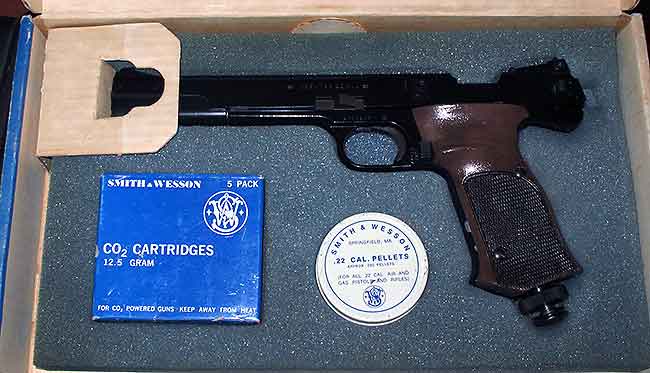
Smith & Wesson 78G.
Webley Senior spring-piston air pistol Part 8
Testing new pellets
This report covers:
- The back story
- Stand-alone test
- The test
- H&N Baracuda 15
- H&N Baracuda 18
- H&N Baracuda Hunter Extreme
- JTS Dead Center
- H&N Slug HP
- Discussion
- Summary
Today we continue to look at the accuracy of certain newer .22-caliber pellets. We’ve done this with two air rifles in the report titled, Testing new pellets and also with the Webley Senior pistol in Part 8 of that series. That’s why I gave you links to those reports above. Today we expand our look at these pellets to an American classic air pistol — the CO2-powered S&W 78G.
I think we have discovered some things about these newer pellets, plus we have learned a few things about the various airguns used in the tests. Today should be quite interesting!
The back story
This isn’t the only 78G I own. This one came to me in a trade with reader 45Bravo, otherwise known as Ian McKee. He found it in pristine condition. It’s one of the very early models with the adjustable trigger. When Ian resealed it he worried about damaging the finish, so he offered it up to me. It is the pistol shown above and I last reported on it in 2020. Unfortunately I see that the paint has started to flake and you can see that in the picture above.
My other 78G was hot-rodded many years ago. It shoots pellets about 100-150 f.p.s. faster than a standard 78G and you read about it in 2010. It’s a great air pistol but for today’s test I wanted a stock gun and this one is that. The hot-rodded 78G shoots Crosman Premiers at an average 494 f.p.s. This stock one I’m shooting today averages 355 f.p.s. That’s just for comparison.
Stand-alone test
What I want to do today is see what kind of accuracy these new pellets deliver in a stock 78G. I doubt I will also test them in the hot-rodded 78G, but I do plan to test them in the Crosman Mark I.
The test
I shot from 10 meters with the butt of the pistol resting on a sandbag. I shot 5-shot groups to keep this test in line with the test of the Webley Senior. I wore my reading glasses with 1.25 diopter correction to see the front sight as clearly as possible.
H&N Baracuda 15
The first pellet tested was the H&N Baracuda 15. The first pellet scored a 9 that was to the left of the 10-ring on the 10-meter air pistol target, so I knew the pistol sights were where they should be. I didn’t look at the target again until I went downrange to change it. This pellet gave a vertical group at 10 meters that measures 1.351-inches between centers. I had hoped for a little better — especially after seeing that first shot.
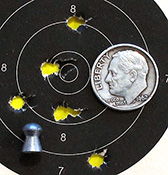
The 78G put five H&N Baracuda 15 pellets into a 1.351-inch group at 10 meters.
H&N Baracuda 18
The second pellet I tried was the 18.13-grain Baracuda 18. This one has also proven accurate in some airguns. But not in the 78G. At 10 meters five pellets went into 1.46-inches at 10 meters. It’s another vertical group and it made me wonder whether or not I was off my game this day. I was resting the pistol and the trigger broke cleanly so I didn’t think that was the case, but then I saw the results.
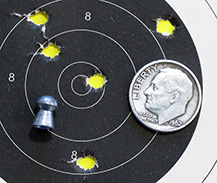
Five Baracuda 18s made a 1.46-inch group at 10 meters.
At this point in the test I was getting discouraged. I know I’m a better pistol shot than this and I think the Smith & Wesson 78G can also be an accurate pellet pistol. These results aren’t horrible, but they sure aren’t wonderful, either.
H&N Baracuda Hunter Extreme
The next pellet I tested was the 18.52-grain H&N Baracuda Hunter Extreme. Unlike the other pellets this one isn’t that new. It’s just a pellet I haven’t done much with in the past. But now that I’ve started testing them I’ve discovered they are often quite accurate.
In the 78G five Hunter Extremes went into 0.722-inches at 10 meters. That’s not just a good group; it’s a great one — the best of today’s test! This pistol can shoot and, apparently, so can I.
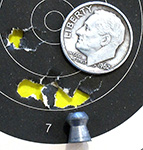
The 78G put five H&N Baracuda Hunter Extremes into a 0.722-inch group at 10 meters.
Now I was cookin’! That nice group set me back on track.
JTS Dead Center
Next up was the Dead Center dome from JTS. These pellets have performed marvelously for us since I brought them home from the SHOT Show this year. In the 78G five of them went into a group that measures 0.922-inches between centers. This is another good pellet for this pistol!
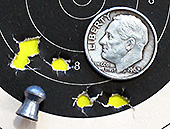
Five JTS Dead Center pellets went into 0.922-inches at 10 meters.
At this point I was satisfied that this S&W 78G is an accurate airgun. It holds gas perfectly and has a great trigger that is two stage and very positive with a crisp stage two break. If you read the full report about this airgun you’ll see that I adjusted the trigger in 2020, and I got it right. Today is a good day!
H&N Slug HP
The last pellet I tested was the 0.218-inch diameter H&N Slug HP. I didn’t think they would be accurate in this pistol and they weren’t. They’ve got to be going too slow to stabilize. Five made a 3.006-inch group at 10 meters. Not only is it the largest group of the test; it’s also way out of proportion with the other groups. You can see that most of the pellet holes in the target are torn out at the right, indicating that the pellet was not flying nose-on. Oddly, in the Webley Senior this slug grouped much better. And that is why we test.
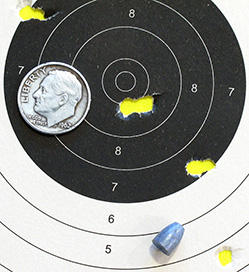
The H&N Slug sized 0.218-inches put five into 3.006-inches at 10 meters.
Discussion
I was pleasantly surprised by how accurate this stock S&W 78G pistol is. With the right pellets it’s formidable.
We will move on to the Crosman Mark I pistol for the next test of new pellets. I can’t wait to see what happens!
Summary
Ian, you done good when you resealed this pistol! It’s a very pleasant shooter. All things considered I like it very much!

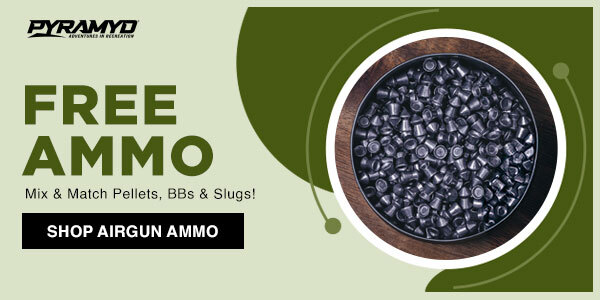
B.B.
How about testing new pellets with new air pistols that anyone can buy today? Even a 2240 would be interesting. Or an HW maybe?
Bill,
The 2240? Good suggestion!
BB
And if you could have the new model with the steel breech and the threaded barrel, now that could be a whole blog.
Bill,
Good suggestion.
Bill,
Yes, that is a good suggestion!
BB
Thank you Tom, I always give my best.
Great shooting, I was very surprised by the 18.52’s performing this well in such a lower powered air pistol.
I would venture a guess that it has to do with the weight distribution, head size and the “moments” of the pellet for want of a better word, but that could be a blog all of its own as to what makes some pellets more accurate than others.
On the flip side of the trade, I am still using the item weekly, and it has only required minimal maintenance.
In addition to still actively shooting airguns, I have been dipping my toe into precision rimfire shooting lately.
And have been tinkering with homemade harmonic barrel tuners, moving the weight forward or backwards as little as .004 of an inch (.1mm) can have a dramatic effect on group size.
I hope everyone had a great weekend!
Ian
Ian and anyone else kind enough
Can you please give me some info about the Tau Brno 7? I found one for 180€ which is supposed to be in excellent condition with all of its accoutrements.
Do you think it’s something worth trying?
For 180euros?
Buy it!
They hold their value well, are relatively easy to service and are loved by anyone who owns one.
There are 3 models, the Junior, the Compact, and the Match.
They tend to get about 60 shots per fill.
I have seen some with both bulk fill options as well as co2 cartridge piercing caps.
If you go the cartridge option, I suggest replacing the oring in the piercing cap with one that does not swell from exposure to the gas, as the factory orings seem to do.
I here are a few links to inform you more than I can type.
Let us know how it goes.
Cheers,
Ian
https://www.airgunforum.ca/forums/topic86258.html
http://www.taubrno.com/tau-7—–compact–walnut-en
https://www.targettalk.org/viewtopic.php?t=65040
Ian
Today I received the Tau 7. Inside its original small suitcase but without a bulk fill bottle. It is in a very good working condition but it has light rust all over. Because of this and the smell I am certain it was kept in a dark humid cellar. The booklet that came with it shows it was made in 2002 and it has a five digit serial number 20… I started already shooting it to make sure it is in working order and I really really like it. This evening I’m going to take out the Ballistol set and start cleaning the rusty surfaces.
By the way the final deal was less than 180 €.
My TAU-7 that I got a few years ago w/ accessories. It shoots well, but I haven’t used it lately.
Ian
“ And have been tinkering with homemade harmonic barrel tuners, moving the weight forward or backwards as little as .004 of an inch (.1mm) can have a dramatic effect on group size.”
This should make a very interesting report by 45Bravo if you are doing it on airguns.
Deck
Deck, Since getting into air airguns years ago I had not thought about those and once I got into 3-D printers and the Air Venturi Avenger suddenly there are many people around the world tinkering with tuners for them.
I had not really thought about doing a blog for it but yes that is a subject for a future blog now that you mention it.
But about 95% of the airgun shooters out there would probably never consider it.
FX offers a tuner for their airguns and there are many 3-D printed versions on the market for the avenger and several other similar guns.
Limb saver is a model for firearms that has been out for decades, and it seems to have ridden a tide where it went into favor, then out, and back in again.
I have seen them used on airguns, but have not tried them myself.
https://limbsaver.com/products/sharpshooter-x-ring-barrel-dampener
I will put this on my whiteboard where I keep my projects so I won’t forget….
I will try to cover models that are on the market, and ones that can be done at home with hardware parts.
Since the majority of Airgunners don’t have 3D printers, I will probably not include print your own designs unless prompted.
Ian
Ian,
Let’s not forget the predecessors to “barrel tuners” in airguns like the HOTS system on Whiscombe’s or the vortex barrel tuner. Here’s a blog B.B. did on the HOTS:
/blog/2007/03/whiscombe-rifles-and-barrel-harmonics-part-4long-range-testing-in-177/
Ian
I tried Limb Saver on a M8 that at one time BB had hopes for but didn’t pan out. It has a trigger that looks similar to the Bronco trigger. I was not able to improve groups. Still, I believe harmonics are an important variable. Thank you for considering doing a report.
Deck
Ian,
With the number of options for 3D printing available (even some public libraries) I think that it might be useful to have a part file available. What format might you use?
Thank you.
Bill
The most commonly used file format at this time seems to be the .STL file format and is supported by almost all software packages.
Another popular one is the .OBJ file format, that is also supported by most slicing software.
The .3MF file format (3D Manufacturing Format) is a newer and better format as it solves many problems of the .STL file such as limited model data storage and low quality prints.
3MF is part of the Linux Foundation, which means that software makers can incorporate it into their products.
The goal was to create a file format for industrial 3D printing that could not only encapsulate more data about a model than the existing .SLT format, but also solve compatibility issues.
Designed with additive manufacturing (3D printing) in mind, 3MF is capable of storing large amounts of model data in one small file, including:
Full color and texture data
Material data
Designer’s name, part description, copyright & licensing data
Thumbnail images
More than one object per scene
Support structures attached to part data
Beam lattices
Scene scale and measurements
Full tray support for direct machine preparation.
Ian
Thanks for this Ian!
I’m keeping a casual eye on the 3D-printing scene and 3MF is something new to me. I’ll do some research on it.
Hank
Tom,
Aren’t you supposed to have a day off today? Isn’t Labor Day a holiday for you?
Siraniko
Today is not Labor Day over here.
First Monday in September.
Siraniko,
No, Labor Day is not a holiday for me. And also, today isn’t Labor Day un the U.S. It’s only that for Australia, as far as I know, though my calendar also says for Queensland, which I thought was part of Australia.
BB
BB,
I know it will ruin the “collector value” of it, but maybe you should consider having that 78G Cerakoted, Alluma-Hyded or something. If not it, then maybe your hot-rodded 78G. I personally like Alluma-Hyde II. It is easy to use and no fuss.
RR,
Oh, sure. And I suppose I should also paint my truck on the outside with bed liner paint? 😉
BB
I have a friend in the sticks of southern Illinois who did that to his “brush” truck, it was 10+ years old at the time. He only used it to go hunting in the deep woods and the scratches from the brush were starting to rust pretty bad. The last I saw of that truck I think his son uses it for the same purpose and now the truck is over 40 years old.
bmwsmiley,
Now that is a legitimate reason for doing it.
BB
Well, if you really want to, I guess it’s alright.
BB
The caption for the picture in the JTS section reads
“Five JTS Dead Center pellets went into 0.922-inches at 25 yards.”
Should say 10m
Ade C,
Ooops! I corrected it, thanks,
BB
B.B.
All my pistols shoot better than that!
What is the big deal?
-Y
Yogi,
Then how about a guest blog? 🙂
BB
At some point I plan on doing a Guest Blog on the saga of my Diana 10M pistol.
First, I am waiting on your blog on how to shoot 10M pistols single handed.
-Y
Yogi,
That report is coming. I am shooting dry-fire shots with my P44 every day, trying to get my groove back. It’s so hard! Getting old is not for sissies! 🙂
BB
on the subject of .22’s, i hope to one day see a report on the norica dream hunter.